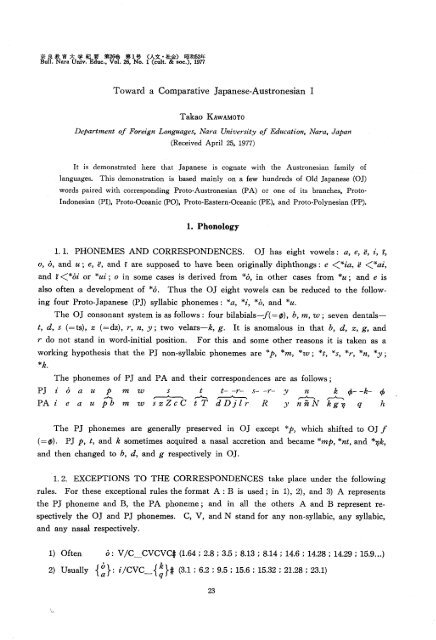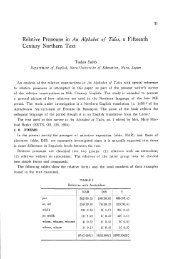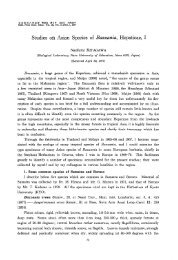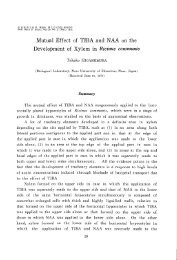Toward a Comparative Japanese-Austronesian I Takao Kawamoto
Toward a Comparative Japanese-Austronesian I Takao Kawamoto
Toward a Comparative Japanese-Austronesian I Takao Kawamoto
You also want an ePaper? Increase the reach of your titles
YUMPU automatically turns print PDFs into web optimized ePapers that Google loves.
i<br />
ull. Nara Univ. : Muo. Vol. 26, No. 1 (cult. & soc), 1977<br />
<strong>Toward</strong> a <strong>Comparative</strong> <strong>Japanese</strong>-<strong>Austronesian</strong> I<br />
<strong>Takao</strong> <strong>Kawamoto</strong><br />
Department of Foreign Longuages, Nara University of Education, Nara, Japan<br />
(Received April 25, 1977)<br />
It is demonstrated here that <strong>Japanese</strong> is cognate with the <strong>Austronesian</strong> family of<br />
languages. This demonstration is based mainly on a few hundreds of Old <strong>Japanese</strong> (OJ)<br />
words paired with corresponding Proto-<strong>Austronesian</strong> (PA) or one of its branches, Proto-<br />
Indonesian (PI), Proto-Oceanic (PO), Proto-Eastem-Oceanic (PE), and Proto-Polynesian (PP).<br />
1. Phonology<br />
1. 1. PHONEMES AND CORRESPONDENCES. OJ has eight vowels: a, e, e, i, I,<br />
o, o, and u; e, e, and I are supposed to have been originally diphthongs: e
24 <strong>Takao</strong> <strong>Kawamoto</strong><br />
3) Often m<br />
4) Usually 0<br />
5) Often {lu\<br />
6) Usually {°u\<br />
7) Sometimes a<br />
8) Usually 6<br />
7/CVCV_# (7.ll ; 7.16 ; 10.4 ; 14.8 ; 15.15 ; 15.16 ; 30.ll ; 36.2)<br />
N/#_VN(G)V (1.64 ; 3.5 ; 4.27 ; 4.28 ; 7.1 ; 8.6 ; 8.22 ; 10.8 ; ll.14...)<br />
V/#C__N(C)V (1.36 ; 1.44 ; 4.27 ; 7.4 ; 7.6 ; 8.6 ; 8.22 ; 12.ll ; 12.25...)<br />
6/C_Ca, CaC___(1.46 ; 2.8 ; 2.9 ; 4.1 ; 4.28 ; 5.1 ; 5.8 ; 8.2 ; 9.4...)<br />
6/CaC_ (7.20 ; 8.6 ; 9.1 ; 25.9)<br />
u/C_C6, C6C__ (1.15 ; 4.19 ; 4.21 ; 12.5 ; 15.9 ; 16.9 ; 28.27)<br />
9) Sometimes -f°\ : o/CwC_, C_Cu (1.37 ; 8.14 ; 31.8)<br />
10) Usually o: m/C_| (1.2 ; 1.36 ; 1.71 ; 1.76 ; 4.10 ; 5.13 ; 6.1 ; 10.ll ; 12.13...)<br />
The numbers in parentheses refer to the examples in the list of words below (§2),<br />
but they are not exhaustive.<br />
1. 3. OJ PHONEMES AND SYLLABLES AND LIMITS OF THEIR COMBINATION.<br />
The following combination of phonemes never occur in OJ : any dental+if; any dental+8 ;<br />
w+i, w+e, and zv+u. No bilabials combine with b to form a monosyllabic morpheme.<br />
OJ syllables are always open : V or CV. Neither VV nor CC occurs. Generally I and<br />
e occur only word-finally, and 6 does not usually co-occur either with a or with u in a<br />
morpheme. No two Cos may be consecutive within a morpheme.<br />
1. 4. VOWEL AND CONSONANT ALTERNATION IN MORPHEMES. In addition<br />
to the correspondences and the exceptional rules, it is necessary to consider that both in<br />
OJ and in PA a morpheme may often have its variant form with the alternation of vowels<br />
or consonants.<br />
1. 41. VOWEL ALTERNATION. OJ examples a~b : madaki premature, mbdbki<br />
a plant similar but inferior to another; w~z : (kinb)fu (yester) day, fi day, sun; w~6:<br />
kurum-i to wrap, kbrbmb robe.<br />
PA examples a~u : karkar, kurkur kratzen ; a~e : kabal, kebel Unverwundbarsein ;<br />
a~i : kaskas kratzen, kiskis schaben ; u~i : ubaq, ibaq anderssein ; u~e : su(m)pit, se(m)pit<br />
engesein.<br />
1. 42. CONSONANT ALTERNATION. OJ examples f~w~m :fase be quick, wase<br />
early-ripening, ModJ mase precocious ; £~y~« : itami, yami pain ; taka tall, naga long ;<br />
s~y*~n; isa, iya, ina no! ; r~y~n: -raka, -yaka -like; ara, ana alas! ; f~b: afaki excavate,<br />
abaki expose (secret) ; k~g: faki wear (socks), fagi-put (feather) on (a stick to<br />
make an arrow) ; £~s: tane, sane seed; t-r: mato, maro round.<br />
PA examples p~b*~m: pajjpayi aus einander stehen, barjba-q ausgebreitet; baya<br />
offenstehen, marqa Vulva ; t~d~n : tektek abhacken, dakdak mit Hammer schlagen ; tipis,<br />
nipis dunnsein ; k~g~y : tcrqkap, tatjgap ergreifen ; pakan Futter, pa-yon Essen ; l~n :<br />
lamuk, namuk Miicke ; t~z : ta(m)bat festbinden, za(m)bat zugreifen.
<strong>Toward</strong> a <strong>Comparative</strong> <strong>Japanese</strong>-<strong>Austronesian</strong> I 25<br />
2. Lexicon<br />
2.0. A CLASSIFIED LIST OF OJ WORDS PAIRED WITH PA, PI, PO, PE, OR<br />
PP MORPHEMES. The semantic classification of words done by Hattori (Hattori 1964)<br />
has been borrowed here. The classification is done for the purpose of emphasizing the<br />
fact that these few hundreds of cognate or possibly cognate words not only include basic<br />
concepts but also they are distributed over all the 35 semantic categories.<br />
The words under each category are arranged in alphabetical order. In square brackets<br />
the numbers refer to the exceptional rules (§1.2), and the sign (~) is used to indicate that<br />
a vowel or consonant alternation is to be considered. The arrow head () are read as ' develops from ' and 'Refer to' respectively.<br />
Frequently Middle <strong>Japanese</strong> (MJ) and occasionally Modern <strong>Japanese</strong> (ModJ) words are<br />
quoted, whenever necessary. MJ is conveniently defined here, though '•Eontrary to the tradition,<br />
as the language of the Heian, the Kamakura, and the Muromachi periods (ca. 9th<br />
c.~16th a), because by the beginning of these periods the eight vowel system had been<br />
collapsed and that of five vowels established, which remains essentially unchanged till the<br />
present day. ModJ is the language of the Yedo period and after it; one of the most distinct<br />
phonological features of ModJ is the loss of labiality from OJ and MJ f or its shift<br />
to h before all the vowels except u.<br />
2. 1. PARTS OF THE BODY; BODY FUNCTIONS.<br />
1) abara-fone MJ
26 <strong>Takao</strong> <strong>Kawamoto</strong><br />
17) fusi knot, joint. 1><br />
18) huke ModJ dandruff
<strong>Toward</strong> a <strong>Comparative</strong> <strong>Japanese</strong>-<strong>Austronesian</strong> I 27<br />
Paar : go together, accompany one another ; any substance branching out.<br />
51) maN-ko ModJ vulva -PA bayja: maya id. => ciNko.<br />
52) mata crotch, matag-e stand with one's legs apart, matag-ari sit astride, stride<br />
28 <strong>Takao</strong> <strong>Kawamoto</strong><br />
82) tuku-baf-i MJ prostrate oneself - PA Du-qkul krummer Koperteil ; papak Flachsein ;<br />
PP tukupapa to prostrate.<br />
83) tum-a, tum-e nail, finger-tip, turn-ami hold between fingers [/~5, ra~/] - PI zu{m)put<br />
mit Fingern Nehmen.<br />
84) ura back, rear, buttock, urakak-i (of an arrow) pierce to the back tuma.<br />
87) yume dream ^ img.<br />
2. 2. LIFE AND DEATH ; HEALTH AND DISEASE.<br />
1) cuwasi ModJ dial, press the pus out
<strong>Toward</strong> a <strong>Comparative</strong> <strong>Japanese</strong>-<strong>Austronesian</strong> I 29<br />
juicy.<br />
7) wo man, male [w~/]-PA pu Herr z$> me.<br />
8) womina woman[w~/, 1, m~f]-PO babine (PA binay) id.<br />
9) wbtb-ko, wotd-me marriageable man (woman)
30 <strong>Takao</strong> <strong>Kawamoto</strong><br />
2) azi Okinawa dial, daimio f|\<br />
3) fari MJ pitch a camp - PI parij Befestigungs-Anlage.<br />
4) fatari to tax, to levy-PA [pd\taRuq Hinsetzen; PA pa- pref. of goal.<br />
5) fiziri emperor, saint
<strong>Toward</strong> a <strong>Comparative</strong> <strong>Japanese</strong>-<strong>Austronesian</strong> I 31<br />
2) ayu-mi to walk, to move one's legs- PA ayun Schaukeln.<br />
3) fana-re go away, part - PApanaw Gehen, Fortgehen.<br />
4) funa, fune 1. feme.<br />
5) ikada raft [a~6] - PA iket[an\ bundle.<br />
6) ini to leave -C^inuy-i
32 <strong>Takao</strong> <strong>Kawamoto</strong><br />
14) musub-i to contract, to promise 4. tuma.<br />
16) nige run away from
PI setagi Band, Schnur.<br />
<strong>Toward</strong> a <strong>Comparative</strong> <strong>Japanese</strong>-<strong>Austronesian</strong> I 33<br />
2. ll. FOOD AND DRINK.<br />
1) adi taste
34 <strong>Takao</strong> <strong>Kawamoto</strong><br />
15) nifa place of hunting, fishing ; yard ; flat land ; calm ife.<br />
20) takh burn (incense), yaki burn, scorch [t, y~s] - PI saqit Versengen, Stinken.<br />
21) takiv boil, cook, heat - PA da-q-darq Erhitzen.<br />
22) tatamii straw mat [m~f] - PI lampit Matte aus Rotan.<br />
23) tatamii pile up, fold up - PI la(m)pis platte Schicht.<br />
24) to door, [10] -PI pin-tu id.<br />
25) tubo MJ courtyard 5. miyake.<br />
27) yaki burn d$> takh.<br />
28) yu hot spring, bath, hot water [.y~£] - PI an-Duy Baden.<br />
2. 13. WORK.<br />
1) asa-ri to search for (food) 1. kaki.<br />
5) kbr-i hew - PA keRet Abschneiden ^> kari.<br />
6) mu-mak-i pasture [6] - PA \rn\einpatj Absperrung.<br />
7) sifo act of dipping cloth into dye -PO (n)si-sipo go down into water.<br />
8) ta paddy field - PA sabaq bewassertes Reisfeld.<br />
9) tayu-si be tired i> 2. naye.<br />
10) wan-a snare, we bait
<strong>Toward</strong> a <strong>Comparative</strong> <strong>Japanese</strong>-<strong>Austronesian</strong> I 35<br />
8) katum-a bamboo basket [3] - PA kaTwq Korb.<br />
9) ka, ke vessel, container
36 <strong>Takao</strong> <strong>Kawamoto</strong><br />
13) kosok-uri MJ (ModJ kusug-uri) to tickle [6~w] - PI gusuk Reiben.<br />
14) kuda-ki break into pieces kudaki.<br />
18) mafari MJ turn round - PI \md\bali-q Winden.<br />
19) muk-i MJ strip, peel [m~~f] - PA buka Offnen : aufdecken.<br />
20) musi-ri MJ pluck [m~f, s~i] - PApuTik Abpfliicken.<br />
21) nagam-il MJ take a view of [»~*, tw~/]
<strong>Toward</strong> a <strong>Comparative</strong> <strong>Japanese</strong>-<strong>Austronesian</strong> I 37<br />
2. 16. EXISTENCE ; CHANGE ; SIMILARITY.<br />
1) art be, appear, take place (ari-ari MJ clear, vivid, visible) ari.<br />
8) narii become [«~s] - PI zadi Werden.<br />
9) nbkbr-i be left alone 8. nige, nogare, 15. nuki.<br />
10) nbr-i be like [n~t, o~«] -PI tuRut : copy, imitate.<br />
ll) tomb follower, friend [o~a] ^> 4. tuma.<br />
12) wor-i sit, be [w~/] - belum Leben.<br />
2. 17. ABILITY ; ACTS.<br />
1) afe endure, withstand
38 <strong>Takao</strong> <strong>Kawamoto</strong><br />
1) faka grave [/~w/| - PA ru-wat) id.<br />
2) foki
<strong>Toward</strong> a <strong>Comparative</strong> <strong>Japanese</strong>-<strong>Austronesian</strong> I 39<br />
14) kci2, sika 12. kafara.<br />
16) kara MJ shell-PA karaq id.<br />
17) keNkeN MJ cry of a pheasant (koNkoN ModJ cry of a fox)
40 <strong>Takao</strong> <strong>Kawamoto</strong><br />
15) miru green sea weed \m~~f\ ^> firu.<br />
16) mo
<strong>Toward</strong> a <strong>Comparative</strong> <strong>Japanese</strong>-<strong>Austronesian</strong> I 41<br />
3) idu-mi spring, well ^> 2. ide, ll. tnidu.<br />
4) mama, ModJ dial, haba
42 <strong>Takao</strong> <strong>Kawamoto</strong><br />
Windstille.<br />
17) siduk-u drop of water
<strong>Toward</strong> a <strong>Comparative</strong> <strong>Japanese</strong>-<strong>Austronesian</strong> I 43<br />
2.27. TIME.<br />
1) aki autumn, harvest
44 <strong>Takao</strong> <strong>Kawamoto</strong><br />
9) * fifty (=5x10) fo.<br />
10) i-tu five - PA batu stone, numeral coefficient ; cf. Malay<br />
satu one PI gas Entzweisein.<br />
12) ko- little 4> 4. £o.<br />
13) kokono nine - PI genep Vollzahligsein ; cf. Sunda. ganap six.<br />
14) mi three fo.<br />
17) mor-i fill, heap up [w~/] - PI pel-pel id.<br />
18) ma, mu-yu six 4. ofo.<br />
20) sa£a unit of length, capacity - PI zartjka MaB.<br />
21) 5
<strong>Toward</strong> a <strong>Comparative</strong> <strong>Japanese</strong>-<strong>Austronesian</strong> I 45<br />
2.30. COLORS; SOUNDS; SMELLS.<br />
1) afa-afa-si light (of color, taste), faint (of light), pale :> 18. afatasi.<br />
2) aka, ak'e
46 <strong>Takao</strong> <strong>Kawamoto</strong><br />
2. 33. PRONOUNS, DEMONSTRATIVES, ETC.<br />
1) a, a-re (MJ ako) 1st pers. sg.-PA aku, PE au id.<br />
2) ana, na, na-re 2nd pers. sg. - PA ini, PE ena, ina that, those (near addressee).<br />
3) ani how?-PA ( )anu( ) Jemand, Etwas (Ersatz einer Benennung) : was?, Sache.<br />
4) i-ku how many? how much?-PA ( )kuha{ ) wie?<br />
5) kimi 2nd pers. sg. honorific - PA kamu, kamiu kimiu 2nd pers. pi.<br />
6) kimu-tati 2nd pers. pi. honorific, kimu=kimi [w~t] -f>, ^> tata'.<br />
7) kimu-ti MJ 2nd pers. sg. honorific, kimu -f>, £/ -PA DiRi selbst.<br />
8) koto thing, matter, fact, question ; word, voice, poem, rumor, saying, language 30. oto, 20. uta.<br />
9) mono something hard to name ani.<br />
10) -mu-tii commonhonorific - PA mu 2nd pers. pi., DiRi selbst.<br />
ll) -muti-i affetional 8. mutumasi.<br />
12) na\ 1st pers. sg.-PE nau id.<br />
13) nai 2nd pers. sg., na-muti id. honorific or affectional ^> ana, mutii, muti ani.<br />
15) owo, ono-re oneself - PA ini, PE ewt, ani this, these (near speaker), => ana.<br />
16) ono-ga-zisi everyone, severally ; dno ft1,.gvz connective i> 34. gvz, zz'st kimuti, muti\.<br />
22) wa, wa-re 1st pers. sg. -PP w-awid.<br />
2. 34. PARTICLES AND OTHER SYNONYMOUS FORMS.<br />
1) fata mata or, or else, either... or [f~m, t~s] -PA pasatj Paar.<br />
2) ga possession of emotional relation - PE -rjka id.<br />
3) kara cause, reason -PA kal id.<br />
4) made
<strong>Toward</strong> a <strong>Comparative</strong> <strong>Japanese</strong>-<strong>Austronesian</strong> I<br />
47<br />
14) tame
48 <strong>Takao</strong> <strong>Kawamoto</strong><br />
1965. Formosan evidence for some new Proto-<strong>Austronesian</strong> phonemes, Lingua 14.<br />
ECHOLS, M. J. & SHADILY, H. 1972 (1963). An Indonesian-English dictionary 2nd ed., Ithaca &<br />
London : Cornell U. P.<br />
FOX, C. E. 1947. Phonetic laws in Melanesian languages, Journal of the Polynesian Society [=JPS] 61.<br />
1948. Prefixes and their functions in Oceanic languages, JPS 62.<br />
HATTORI Shiroo 1964. An Ainu dialect dictionary, Tokyo : Iwanami ShoteN.<br />
IVENS, W. G. 1918. Dictionary and grammar of the language of Sa'a and Ulawa, Solomon Islands,<br />
Washington.<br />
IZTJI Hisanosuke 1975. Marai-porineshia shogo-hikaku to keitoo, Tokyo : KoobuNdoo.<br />
KAWAMOTO <strong>Takao</strong> 1974. NihoNgo to naNtoogo (shutoshite meraneshia shogo) to no gokukoosei-joo<br />
no idoo ni tsuite, MiNzokugaku KeNkyuu 39/2.<br />
1974, -75, -76. NihoNgo no shoochoogo no gogeN-tokuni naNtoogo ni kaNreN shite 1, 2, 3,<br />
Bulletin of Nara Univ. of Education 23/1, 24/1, 25/1.<br />
1975. NihoNgo no suushi no kigeN, KikaN JiNruigaku 6/2, Tokyo : KoodaNsha.<br />
1976a. NihoNgo no dooshi katsuyo taikei no seiritsu to kigeN, KikaN J. 7/1.<br />
1976b. NihoNgo shiNzoku meishoo gogeNkoo, MiNzokugaku K. 41/1.<br />
KINDAICHI Haruhiko ed. 1974. ShiN meikai kokugo jiteN 2nd ed., Tokyo : SaNseidoo.<br />
KOKURITSU KOKUGO KENKYUUJO 1969. Okinawago jiteN, Tokyo : Ookurashoo INsatsukyoku.<br />
MABUCHI Kazuo 1971. Kokugo oNiNroN, Tokyo : Kasama ShoiN.<br />
MATUMURA Akira 1971. NihoN buNpoo daijiteN, Tokyo : Meiji ShoiN.<br />
MILKE, Wilhelm 1961. BeitrSge zur ozeanischen Linguistik, Zeitschrift fur Ethnologie 86.<br />
1965. <strong>Comparative</strong> notes on the <strong>Austronesian</strong> languages of New Guinea, Lingua 14.<br />
MILNER, G. B. 1972. Fijian grammar, Suva, Fiji : Government Press.<br />
MURAYAMA Shichiroo 1974a. NihoNgo no gogeN, KoobuNdoo.<br />
1974b. NihoNgo no keNkyuu-hoohoo, KoobuNdoo.<br />
1975. Kokugogaku no geNkai, KoobuNdoo.<br />
NIHON DAIJITEN KANKOOKAI 1972-6. NihoN kokugo daijiteN 20 vv., Tokyo : ShoogakukaN.<br />
OMODAKA Hisakata et al., eds. 1967. Jidaibetsu kokugo daijiteN, joodai-heN, SaNseido.<br />
OONO Susumu 1955. NihoNgo, VII. Rekishi, VIII. Keitoo, Sekai geNgo gaisetsu Vol. II, Ichikawa &<br />
Hattori, eds., Tokyo : KeNkyusha.<br />
1957. NihoNgo no kigeN, Iwanami ShoteN.<br />
1974. NihoNgo o sakanoboru, Iwanami S.<br />
et al., eds. 1974. Iwanami kogo jiteN, Iwanami S.<br />
PAWLEY, Andrew 1966. Polynesian languages : a subgrouping based on shared innovations in morphology,<br />
JPS 75.<br />
PUKUI, Mary Kawena & ELBERT, Samuel H. 1971. Hawaiian dictionary, Honolulu : Univ. of Hawaii P.<br />
RAMOS, Teresita V. 1971. Tagalog dictionary, Univ. of Hawaii P.<br />
RAY, Sidney Herbert 1926. A comparative study of the Melanesian island languages, Cambridge.<br />
REID, Lawrence A. 1971. Philippine minor languages : word lists and phonologies, Oceanic linguistics<br />
special publication No. 8, Univ. of Hawaii P.<br />
SEBEOK, Thomas A., ed. 1971. Current trends in linguistics 8. Linguistics in Oceania, Mouton.<br />
STIMSON, J. F. & MARSHALL, D. S. 1964. A dictionary of some Tuamotuan dialects of the Poly<br />
nesan language, The Hague : Martinus Nijhoff.<br />
TAKETOMI Shooichi 1942. Maraigo daijiteN, Tokyo : OobuNsha.
<strong>Toward</strong> a <strong>Comparative</strong> <strong>Japanese</strong>-<strong>Austronesian</strong> I 49<br />
TOOGOO Yoshio 1968. Heian jidai no no, ga ni tsuite, Kokugogaku 75.<br />
TREGEAR, Edward 1969. Maori-Polynesian comparative dictionary, Oosterhout N. B., The Netherlands,<br />
Photomechanic reprint after the edition of Wellington, N. Z., 1891.<br />
WILLIAMS, H. W. 1971. A dictionary of the Maori language, "Wellington.<br />
WINSTEDT, Richard 1970. An unabridged Malay-English dictionary sixth ed., Kuala Lumpur/<br />
Shingapore ; Merican & Sons.





